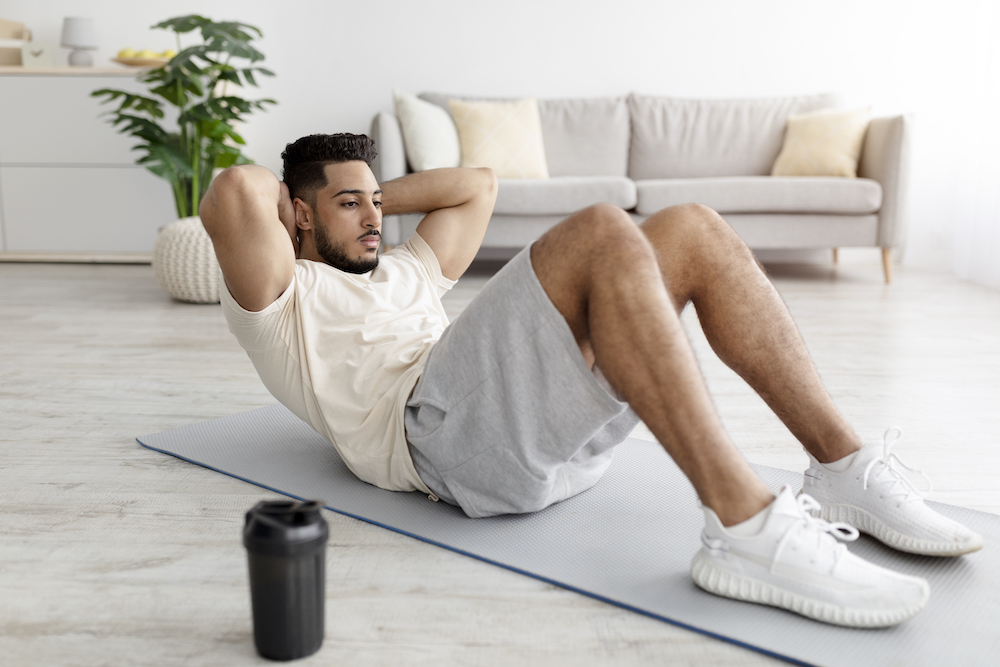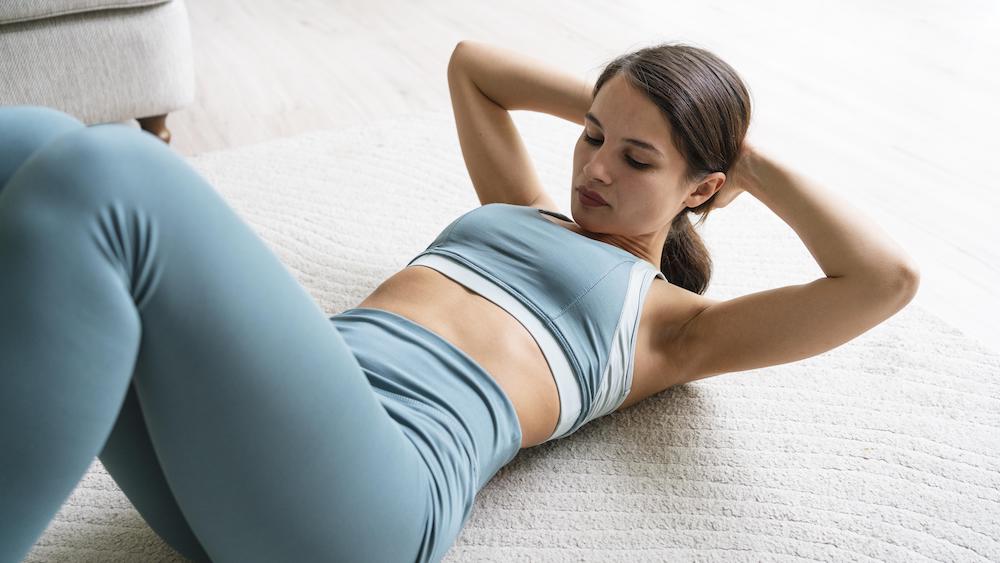When it comes to core-strengthening exercises, the crunch stands as a timeless classic. This simple yet effective exercise targets your abdominal muscles, helping you achieve a strong and defined midsection. In this comprehensive guide, we’ll walk you through the steps of performing a crunch correctly to maximize its benefits while minimizing the risk of injury. Let’s dive in and learn how to master the art of the crunch!

What is a crunch exercise?
The crunch is an isolation exercise that primarily targets the rectus abdominis muscle – the front layer of your abdominal wall responsible for that coveted six-pack appearance. Unlike a full sit-up, the crunch involves lifting only your upper back and shoulders off the ground, reducing strain on your lower back.

Performing the perfect crunch
Performing a proper crunch is more than just lifting your upper body off the ground. It’s about engaging the right muscles, maintaining correct form, and understanding the subtleties that lead to its effectiveness. In this comprehensive guide, we’ll walk you through the step-by-step process of performing a crunch with precision and finesse. From setting up the perfect groundwork to executing each movement flawlessly, get ready to unlock the secrets of the crunch!
Step 1 -> Set up
- Find a comfortable and flat surface, like a yoga mat, to lie down on.
- Bend your knees and plant your feet flat on the ground, hip-width apart.
- Keep your arms comfortably at your sides or gently place your hands behind your head, fingers interlaced. Avoid pulling on your neck.
Step 2 -> Engage your core
- Take a deep breath in.
- As you exhale, engage your core muscles by pulling your navel towards your spine. This action helps stabilize your spine and protect your lower back.
Step 3 -> Initiate the movement
- With your core engaged, slowly start lifting your head, shoulder blades, and upper back off the ground. The movement should be initiated from your core, not by pulling on your neck.
- Keep your gaze fixed towards the ceiling to maintain a neutral neck position.
Step 4 -> Crunch up
- Continue lifting until your shoulder blades are off the ground. Your lower back should still be in contact with the mat. The motion is a short and controlled movement, not a full sit-up.
- Avoid using momentum or pulling on your neck to lift yourself. Focus on using your abdominal muscles to perform the movement.
Step 5 -> Hold and squeeze
- At the top of the movement, hold the contraction for a moment. Focus on squeezing your abdominal muscles to intensify the engagement.
- Keep breathing throughout the movement – exhale as you crunch up and inhale as you lower down.
Step 6 -> Lower down
- Inhale as you slowly lower your upper back and shoulder blades back down to the mat. Maintain control and engagement of your core muscles.
- Your lower back should remain in contact with the mat throughout the entire exercise.
Focus on this
- Quality over quantity: Focus on performing each crunch with proper form, rather than rushing through a high number of reps.
- Engage your core: The key to an effective crunch is engaging your core muscles throughout the entire movement.
- Avoid neck strain: Don’t pull on your neck with your hands; instead, use them for support. Keep your gaze towards the ceiling to maintain a neutral neck position.
- Breathe: Exhale as you crunch up and inhale as you lower down. Breathing properly helps engage your core and stabilize your body.
- Start slow: If you’re new to crunches, begin with a lower number of repetitions and gradually increase as your core strength improves.
- Combine with a balanced workout: While crunches can help strengthen your core, a well-rounded workout routine that includes cardio, strength training, and flexibility exercises is essential for overall fitness.
Common mistakes to avoid
Crunches may seem straightforward, but improper form can lead to discomfort, reduced effectiveness, and even potential injury. Here are some common mistakes to steer clear of:
- Arching your back excessively.
- Using momentum to lift yourself up.
- Placing your hands behind your neck and pulling on it.
- Relying solely on crunches for a flat stomach without incorporating a balanced diet and overall fitness routine.
Workout with Fit at Home!
Fit at Home is your NUMBER ONE fitness app! With a variety of home workouts for the whole family. With our workouts you can achieve your fitnessgoal. Whether you want to lose weight, improve your strength, let your kids exercise more often, stay fit during your pregnancy etc.
Transform your TV into your personal gym

Fit at Home is there to empower you to take charge of your health and fitness journey from the comfort of your living space. By embracing the flexibility of home workouts, designing a balanced routine, staying motivated, and prioritizing recovery and nutrition, you’ll embark on a path to a healthier and more vibrant life. Remember, it’s not about perfection; it’s about progress and consistency. So, let’s lace up those sneakers, roll out the mat, and embark on a fitness adventure that’s tailor-made for you!
We love to make you move!
✓ Work out in front of your tv whenever you want
✓ 24/7 on-demand with more than 500 workouts
✓ For the whole family

Combine a crunch in these workouts
Crunches are a popular exercise primarily used for targeting and strengthening the abdominal muscles, specifically the rectus abdominis. They are commonly included in workouts that focus on core strength and toning. Here are some types of workouts and fitness routines where crunches are often incorporated:
- Abdominal workouts:
- Crunches are a staple in traditional abdominal workouts. They help isolate and strengthen the front part of your core.
- Core workouts:
- Crunches are often included in broader core workouts that target various muscles in the torso, including the obliques and transverse abdominis.
- Home workouts:
- Since they require minimal equipment, crunches are popular in home workouts where people may not have access to gym equipment.
- Bodyweight workouts:
- Crunches can be done without any equipment, making them suitable for bodyweight workouts and routines that emphasize using your own body for resistance.
- Pilates:
- Crunches are a common exercise in Pilates routines, where they are performed with precise form and control to improve core strength and stability.
- HIIT (High-Intensity Interval Training):
- Some HIIT workouts incorporate crunch variations to add intensity and target the core while maintaining a high heart rate.
- Boot camp workouts:
- In boot camp-style workouts, crunches may be combined with other exercises for a full-body workout.
- Yoga:
- Yoga practices sometimes include crunch-like movements as part of core-strengthening sequences.
- Physical therapy:
- Physical therapists may use modified crunches as part of a rehabilitation program for individuals recovering from certain injuries or surgeries.
- Group fitness classes:
- In group fitness classes, such as core-focused classes or circuit training, crunches are often included to work on core strength and stability.
It’s important to note that while crunches can be effective for strengthening the abdominal muscles, they should be performed with proper form to minimize the risk of back strain or injury. Additionally, it’s advisable to include a variety of core exercises in your routine to work all aspects of the core and maintain a balanced, functional core strength.